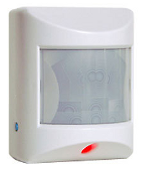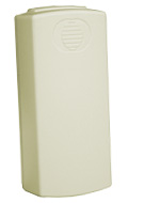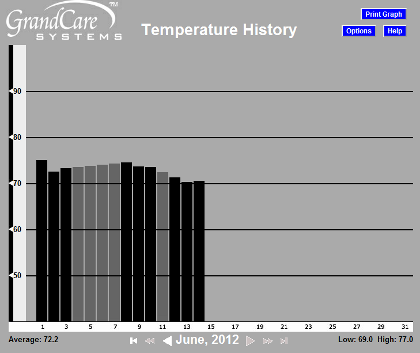Difference between revisions of "Temperature"
| Line 1: | Line 1: | ||
[[File:ZWaveTempSensor.png|right|frame|Z-Wave Temperature and Motion Sensor]] | [[File:ZWaveTempSensor.png|right|frame|Z-Wave Temperature and Motion Sensor]] | ||
[[File:InovonicsTempSensor.png|right|frame|Inovonics Temperature Sensor]] | [[File:InovonicsTempSensor.png|right|frame|Inovonics Temperature Sensor]] | ||
[[File: | [[File:TempGraph.png|right|frame|Temperature Graph]] | ||
<h3 style="display: inline-block; background:#ffffff; font-weight:bold; border-bottom:2px solid #6093cc; text-align:left; color:#000; padding:0.2em 0.4em;"><br />Overview</h3> | <h3 style="display: inline-block; background:#ffffff; font-weight:bold; border-bottom:2px solid #6093cc; text-align:left; color:#000; padding:0.2em 0.4em;"><br />Overview</h3> | ||
If you are concerned that your loved one's home might get too hot or too cold, a wireless temperature sensor can help you. The sensor reports the current indoor temperature, as well as graphs of the temperature over time. You can set limits for how high or low the temperature can be, so you and other caregivers can receive alerts if those limits are exceeded. You can receive alerts on outside temperatures as well, based on the temperatures reported by the GrandCare weather forecast.<br /><br /> | |||
<h3 style="display: inline-block; background:#ffffff; font-weight:bold; border-bottom:2px solid #6093cc; text-align:left; color:#000; padding:0.2em 0.4em;">Types of Sensors</h3> | <h3 style="display: inline-block; background:#ffffff; font-weight:bold; border-bottom:2px solid #6093cc; text-align:left; color:#000; padding:0.2em 0.4em;">Types of Sensors</h3> | ||
There are two different types of temperature sensors that can be used with your loved one's GrandCare system. One is a combination sensor that does double duty as both a motion sensor and a temperature sensor. The other is a dedicated temperature sensor. | There are two different types of temperature sensors that can be used with your loved one's GrandCare system. One is a combination sensor that does double duty as both a motion sensor and a temperature sensor. The other is a dedicated temperature sensor. Your GrandCare representative or installer should help you choose the sensors that are right for your needs. If those needs change, different sensors can be added to the system at a later date. As part of the installation process, the sensors must be paired with your system, so that the signals are picked up properly. <br /><br /> | ||
Revision as of 20:38, 14 June 2012
Overview
If you are concerned that your loved one's home might get too hot or too cold, a wireless temperature sensor can help you. The sensor reports the current indoor temperature, as well as graphs of the temperature over time. You can set limits for how high or low the temperature can be, so you and other caregivers can receive alerts if those limits are exceeded. You can receive alerts on outside temperatures as well, based on the temperatures reported by the GrandCare weather forecast.
Types of Sensors
There are two different types of temperature sensors that can be used with your loved one's GrandCare system. One is a combination sensor that does double duty as both a motion sensor and a temperature sensor. The other is a dedicated temperature sensor. Your GrandCare representative or installer should help you choose the sensors that are right for your needs. If those needs change, different sensors can be added to the system at a later date. As part of the installation process, the sensors must be paired with your system, so that the signals are picked up properly.


